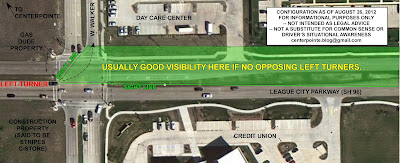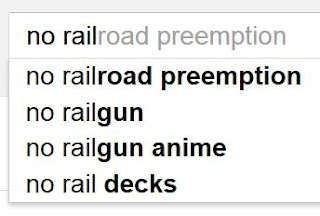This post follows up
my August 26 entry where I wondered whether pickers really
are an issue with which we should be concerned. No concise backstory has yet emerged on that issue - no definitive example of a picker ever having caused a problem here or been responsible for any actual theft.
Of course, the inverse is also true - there's no definitive evidence that pickers have
never been responsible for a theft.
But by the same logic, though, there's no definitive evidence that someone's
lawn crew has never been responsible for a theft.
In fact, if I had to suspect any entity of conducting theft surveillance, it wouldn't be the pickers, who (to my knowledge) have never been eye-witnessed anywhere but squarely in public rights-of-way, and whose individual truck license plate numbers are easily recordable for anyone who wants to take the time to do it.
If I were going to suspect someone, it would be the myriad lawn crews, who literally have a weekly opportunity to enter peoples' back yards and peer closely into every window of every house they serve (knowing full well who is home and who is not home at the time when they do it). It's the perfect front for surveillance. Let's be honest about this: how many people in Centerpointe actually know the names of each of their lawn crew members? How many people pay their lawn crews using any traceable method? Not many - by and large, those are cash transactions, no questions asked. And even if the crew bosses drive motor vehicles with traceable license plates, each one of those guys has two or three anonymous helpers who, in many cases, probably aren't even in the country legally.
If I were going to stake out Centerpointe for theft purposes, that's definitely the route I would go: I'd become a lawn boy. I'd choose the very obvious method that:
- Would not reveal my name
- Would not require me to drive an identifiable car to the target, and
- Which would simultaneously give me direct physical access to all four sides of my target houses, not keep me confined to the public streets where I couldn't see very much.
Do you see the futility of trying to solve a problem for which no evidence exists by using this kind of inference ("it might be the pickers")? It's arguably not logical.
It's also a potential black hole of mushrooming effort. What would happen if we made a concerted effort to get rid of pickers? Dollars to donuts, we'd still have routine thefts. So then we'd get rid of lawn crews next? And
then what?
NEVERTHELESS, it's still worth looking at the issue of recycling / repurposing in general because there are some path-of-least-resistance alternatives of which our residents may not yet be aware. Here are a few good options if you don't wish to simply leave stuff at your curb on trash nights.
(1) Centerpointe Yard Sale. Once a year, usually in the spring before it gets too hot, we have a neighborhood-wide yard sale which attracts a lot of traffic due to the density of sales. More homes with stuff to get rid of makes for more local people interested in buying, so this can be very efficient. Look to the Newsletter or
POA website for information on that.
The communal yard sale has the advantage of drawing a lot of people and getting a lot of unwanted items moved out of here at once. However, it also has the disadvantage of being of limited convenience: I myself have never been able to wait long enough for the next yard sale to roll around. When I clean and reorganize a section of my house or yard, I need to start and finish the job within the
same day because on the
next day, some other responsibility will be demanding my time. I can't half-do the job and wait three months or whatever until the next yard sale is scheduled in order to get rid of the products of that effort (unless they are small and easily stored). I suspect this is true of many people, which is why they consistently set stuff at the curb for pickers. For this reason, there are additional alternatives worth considering.
(2) Goodwill. The old tried-and-true donation standby, and they supply receipts for tax purposes. Here is the
Goodwill locator page. You should check directly with your outlet of choice to verify that they are active; for some reason, Goodwill storefronts tend to move around a lot.
 |
| Here's a Googlemaps screengrab showing active locations as of today's date. Look 'em up. |
(3) Churches. A few local churches have concentrated on garage sales as a revenue stream. Then after they get done selling what can be sold, they truck the residuals to Goodwill. So this is potentially a
win-win-win alternative:
- I believe that you can record the donation for tax purposes (you don't get a tax deduction by giving stuff to pickers, and you don't get a tax deduction by selling in the Centerpointe annual neighborhood garage sale)
- The church gets money to fund its community outreach programs.
- Goodwill gets the remaining items to distribute to people in need.
The church with which I have the greatest familiarity and which has established a robust and high-quality garage sale clientele is
Bay Area Unitarian Universalist Church (BAUUC) which is located under the Clear Lake water tower on El Camino Real. They have church-wide garage sales
twice per year. The
next donation period is October 21-25, 2012, with the resulting public sale taking place October 26-28. I always donate my smaller items to this one, and if anyone would like more info, please contact me via my gmail address which is centerpointe.blog.
(4) Craigslist. Need to get rid of larger or non-donatable items quickly, but don't find palatable the idea of pickers at your driveway in the middle of the night? Then why not simply list your give-aways in
a "Curb Alert" on Craigslist during the bold light of day?
 |
Here's a partial screengrab of an example listing from last weekend.
"Curb alert" means that the poster has set free items out on their curb for anyone who wants them.
This particular address is located in South Shore Harbor. |
This is a very well-established practice, but I do have one recommendation if you choose it: don't list your exact house number. This user could have instead said "one hundred block of Hidden Lake" and not lost any communication efficacy.
If you use Craigslist, you can partially screen who shows up, if you want to do that. You have the option of getting the email and phone number of whoever will be coming your way. You might think to yourself,
"Ooooooh, if I use Craigslist, I might attract an ax murderer!" But think of it from the other party's perspective:
you might BE an ax murderer trying to lure them with an offer of a free couch. Most of the time, the people alerted by this method will want to make contact with you before they collect your stuff. Mutual verification reassures both parties that there's nothing fishy going on. If someone reveals their name, cell phone and email to you, they probably don't have ulterior motives.
I use Craigslist from time to time for large items that are not good candidates for church or Goodwill donation. Do you remember
that post I wrote about the lethality of Sago palms? And how a Sago palm resulted in sixteen hundred dollars of veternarian bills because our dog got poisoned by chewing on it? After that happened, I dug up and listed all of our Sagos on Craigslist, cleaned out our entire yard (we had numerous Sagos, ignorant buggers that we were).
Get this: they were picked up by an oil company executive and are now enjoying the poshest possible lives as balcony container plants in a skyscraper penthouse in downtown Houston. They are literally
fifty stories into the sky where they can no longer poison dogs or small children. I kid you not - that's where my Sagos ended up!! Craigslist
rules!!
:-)
Here's what I gave away this past Saturday afternoon (during the proverbial bright light of day):
 |
A queen palm that needed a new pot, and a Dogloo.
Note that I placed both in the hell strip so that they did not appear to be "within" my yard and thus off limits.
Also, to be absolutely clear, I put a "FREE" sign on the Dogloo so that the sight of someone taking it would not raise the alarm of any of my neighbors. |
People have smart phones with which they monitor sites like Craigslist for new listings. The queen palm disappeared within about an hour. The Dogloo took slightly longer.
(5) Clear Lake Freecycle. I think you need a Yahoo address to post to this. I use it, but don't meet many people that way, though, because the Craiglist people usually get to me first.
Anyway, there's a handful of good alternatives for you if you wish not to encourage our midnight trash pickers.








































